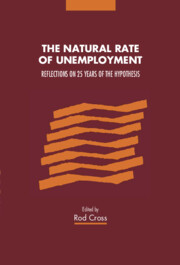Book contents
- Frontmatter
- Contents
- List of Contributors
- Preface
- 1 Introduction
- Part I The theoretical framework
- Part II Adjustment, ranges of equilibria and hysteresis
- 6 The economics of adjustment
- 7 Hysteresis and memory in the labour market
- 8 Models of the range of equilibria
- 9 Hysteresis revisited: a methodological approach
- 10 Is the natural rate hypothesis consistent with hysteresis?
- Part III Empirical tests and macro models
- Part IV Political economy
- Index
8 - Models of the range of equilibria
Published online by Cambridge University Press: 03 May 2011
- Frontmatter
- Contents
- List of Contributors
- Preface
- 1 Introduction
- Part I The theoretical framework
- Part II Adjustment, ranges of equilibria and hysteresis
- 6 The economics of adjustment
- 7 Hysteresis and memory in the labour market
- 8 Models of the range of equilibria
- 9 Hysteresis revisited: a methodological approach
- 10 Is the natural rate hypothesis consistent with hysteresis?
- Part III Empirical tests and macro models
- Part IV Political economy
- Index
Summary
Introduction
An important contribution of the theory of the natural rate of unemployment is to show that a major influence on the actual rate of inflation is the expected rate of inflation. The high rates of inflation experienced in the 1970s and the 1980s in many industrialised capitalist economies would be hard, maybe impossible, to explain without the idea that the expected rate of inflation influences the actual rate. In the 1970s and the 1980s people expected the price level to increase and this expectation influenced their actions in setting wages and prices, thus ensuring that the price level did increase.
The weakness of the theory of the natural rate of unemployment is its postulate of a unique equilibrium rate of unemployment. The behaviour of inflation at high rates of unemployment is inconsistent with a unique equilibrium rate of unemployment and thus with the theory of the natural rate of unemployment. Instead there appears to be a range of equilibrium rates of unemployment. This chapter records some empirical evidence which suggests the existence of a range of equilibrium rates of unemployment and then discusses how customer market analysis and theories of involuntary unemployment can yield a reasonable model of the range of equilibria. A crucial requirement of a reasonable model is an acyclic pattern of real wages.
The remainder of this chapter is organised into five sections. In the second section empirical evidence which suggests the existence of a range of equilibrium unemployment rates is presented for a number of countries.
- Type
- Chapter
- Information
- The Natural Rate of UnemploymentReflections on 25 Years of the Hypothesis, pp. 101 - 152Publisher: Cambridge University PressPrint publication year: 1995
- 9
- Cited by



